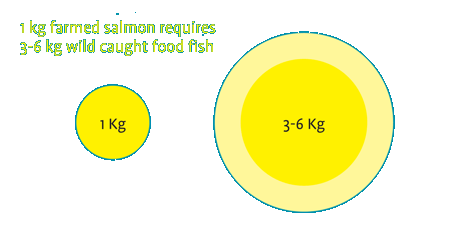|
|

| Broodstocks:
a threat to wildlife and their habitats |
| A
great variety of fish and other seafood comes from fish farms (about 40%
of total world production). This sounds encouraging, considering the extent
of overfishing globally. But in many cases, fish farms have destructive
impact on the ocean ecosystems. Many unique ocean and coastal habitats
have been destroyed in order to establish fish farms. |
| Fish
breeding facilities require great quantities of food fish; 3 - 6 kg of
wild-caught food fish is necessary for the production of 1 kg of salmon
fillet. Antibiotics and other medications are used to promote growth and
to prevent infectious diseases. In addition, non-native breeding fish regularly
escape from aquaculture facilities and displace native fish species either
by eating or out-competing them. During the last 20 years, wild salmon
stocks have decreased by approximately 45%. |

 |
Development
of alternative protein sources for fish farms |
 |
Monitoring
and supervision of fish farms |
 |
Support
of environmentally responsible fish farms |
|
www.salmonfarmmonitor.org |
 |
If
you prefer purchasing wild instead of farmed salmon, please pay attention
to the MSC label. MSC is engaged in maintaining intact marine habitats
and supports responsible fishing methods. |
|
|
|







